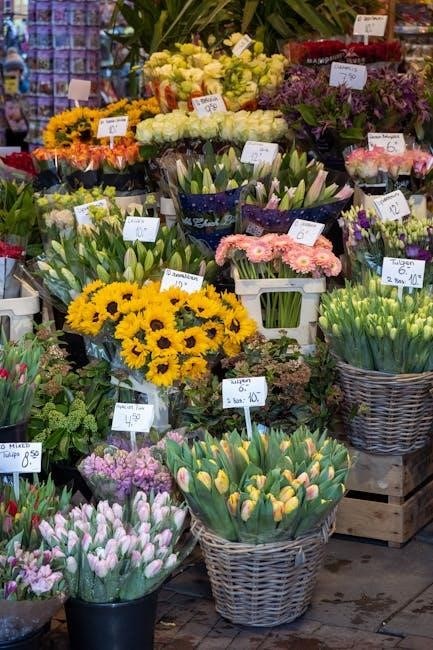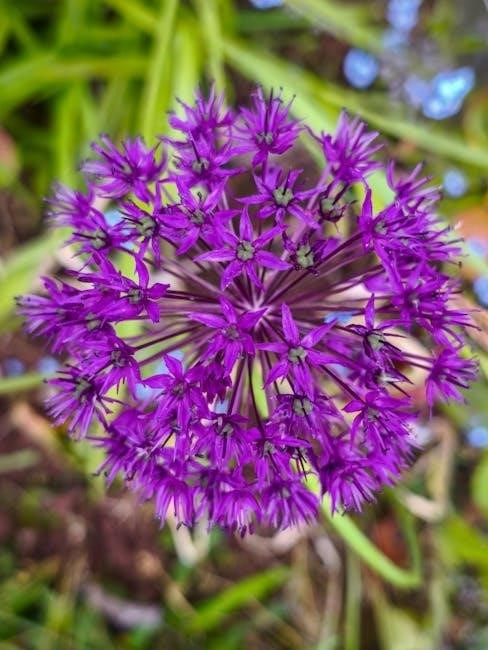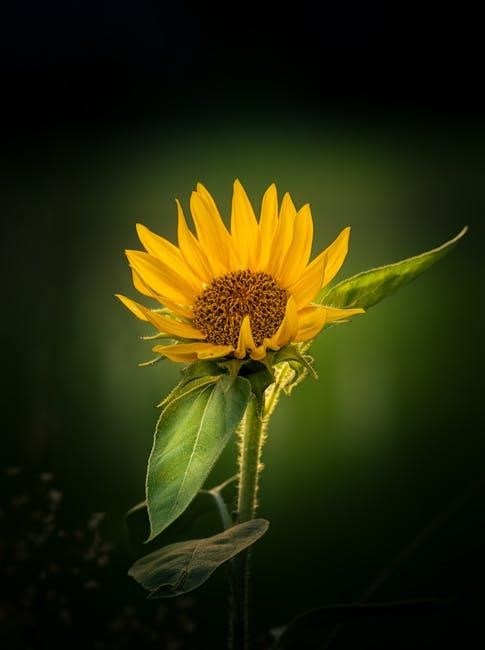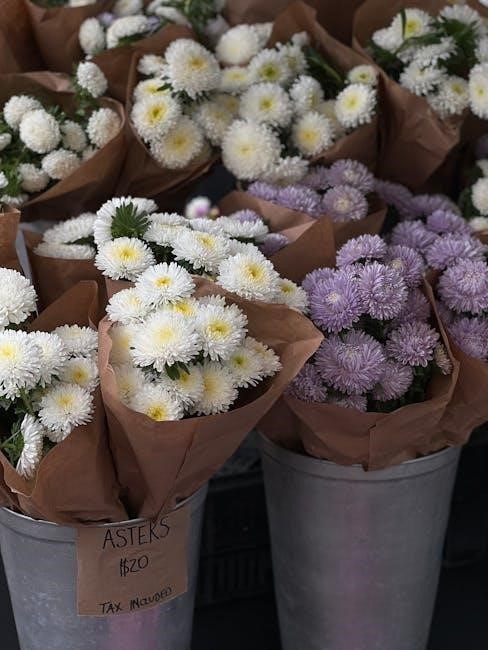Understanding floral pricing is crucial for planning and budgeting. This guide explores factors influencing costs, average prices for arrangements, and tips for calculating expenses. Whether for weddings or everyday bouquets, it helps you make informed decisions.
Floral pricing is a delicate balance of art and science, reflecting the value of materials, labor, and creativity. Understanding how prices are determined helps consumers and florists alike navigate the market effectively. Factors like flower type, seasonality, and design complexity play significant roles in costing. For instance, exotic blooms or intricate arrangements often carry higher price tags due to their rarity and skill requirements. Additionally, geographic location and supply-demand dynamics influence final costs. Whether for weddings, everyday bouquets, or subscription services, pricing must align with client expectations and budgets. This guide provides insights into the key elements shaping floral pricing, offering practical tips for mastering markups and ensuring profitability. By breaking down the components of floral costs, it empowers both buyers and sellers to make informed decisions. From budget-friendly options to luxury arrangements, understanding pricing strategies ensures that every purchase or sale is both cost-effective and satisfying. This foundational knowledge is essential for anyone looking to navigate the floral industry with confidence and clarity.
Understanding Floral Pricing Factors
Floral pricing is influenced by several key factors, including the type of flowers, their availability, and the complexity of the arrangement. High-demand blooms like roses and orchids tend to cost more due to their popularity and care requirements. Seasonality also plays a significant role, as flowers out of season may require importing, increasing their price. Geographic location affects pricing too, with urban areas often having higher rates due to living costs and demand. Labor costs are another critical factor, as skilled florists charge for their time and expertise, especially for custom or intricate designs. Additionally, overhead expenses such as shop rent, marketing, and supplies contribute to the final price. Understanding these factors helps consumers make informed decisions and florists set competitive yet profitable rates. By breaking down these elements, it becomes easier to see why certain arrangements or bouquets are priced higher than others. This transparency ensures a fair balance between quality, creativity, and cost.
How Flower Types Affect Pricing
Different flower types significantly influence pricing due to their rarity, size, and maintenance needs. Exotic flowers like orchids and proteas are often more expensive because they require meticulous care and may need to be imported. Roses, a popular choice, vary in price based on their color and quality, with red roses typically costing more than others. Seasonal flowers, such as peonies or hydrangeas, command higher prices when out of season, as they must be sourced from other regions. Conversely, locally available and in-season blooms like carnations or baby’s breath are more budget-friendly. The size and quantity of flowers in an arrangement also affect the cost—larger blooms or rarer species increase the overall price. Additionally, unique or specialty flowers, such as calla lilies or anemones, often come at a premium due to their distinct appearance and demand. Understanding how different flower types impact pricing helps consumers and florists balance aesthetics and budget effectively.
Seasonal Influences on Floral Costs
Seasonal availability plays a significant role in determining floral costs. Flowers in season are typically more affordable due to higher supply and lower transportation costs. For example, roses are pricier around Valentine’s Day, while peonies and hydrangeas are more expensive in winter when they must be imported. Summer blooms like sunflowers and dahlias are often cheaper during their peak season. Conversely, out-of-season flowers, such as lilies in winter or tulips in summer, cost more due to importation and storage needs. Holiday demand also impacts pricing, with flowers like poinsettias and amaryllis being more expensive during the holiday season. Understanding seasonal fluctuations helps consumers and florists balance beauty and budget. Planning ahead or opting for in-season blooms can significantly reduce costs while still achieving stunning arrangements. Seasonal variations are a key factor in floral pricing, making it essential to consider when selecting flowers for any occasion.
Geographic Location and Pricing Variations
Geographic location significantly influences floral pricing due to factors like availability, transportation, and regional demand. In urban areas, where florists are plentiful, prices may be lower due to competition. Conversely, rural regions often see higher costs because of limited suppliers and delivery challenges. Countries or regions known for flower production, such as the Netherlands or Colombia, may offer more competitive pricing for certain blooms. Local taxes, import fees, and logistics also play a role. For example, importing flowers to islands or remote areas increases costs. Seasonal availability varies by location, affecting prices further. Additionally, demand for specific flowers in certain regions, like Hawaii for orchids, can drive up prices. Understanding these geographic variations helps consumers and florists set realistic expectations and budgets. By considering the location, one can make informed decisions to balance cost and quality for stunning floral arrangements. Geographic pricing differences are a key consideration in the floral industry, shaping how flowers are sourced and sold worldwide.

Average Costs for Common Floral Arrangements
Average costs for floral arrangements vary widely, with wedding flowers ranging from $400 to $10,000. Everyday bouquets typically cost $30-$75, while subscription services may range from $30 to $150 per week, depending on size and frequency.

Wedding Flower Pricing Guide
Wedding flowers are a significant expense, with costs ranging from $400 to $10,000 or more, depending on the scale and complexity of the arrangements. Bridal bouquets typically cost between $100 and $300, while bridesmaid bouquets range from $50 to $150 each. Centerpieces can vary widely, from $50 for simple designs to $300 or more for elaborate creations. Ceremony arrangements, such as arches or aisle decorations, often start at $200 and can exceed $1,000 for intricate designs.
Factors influencing wedding flower costs include the type of flowers, seasonality, and geographic location. For instance, exotic or out-of-season blooms may significantly increase expenses. Additionally, labor costs for custom designs and delivery fees contribute to the overall price. Couples should budget accordingly, prioritizing essential items like the bridal bouquet and centerpieces, and considering simpler options for secondary arrangements.
Planning ahead and discussing preferences with a florist can help couples stay within their budget while achieving their desired aesthetic.
Everyday Bouquet and Arrangement Costs
Everyday bouquets and arrangements are popular for their versatility and affordability. On average, a standard bouquet can cost between $30 and $75, depending on the flowers, size, and design complexity. Simple arrangements, such as a dozen roses or mixed blooms, typically range from $40 to $100. For more elaborate designs or premium flowers like orchids or peonies, prices may increase to $150 or more.
Factors influencing everyday bouquet costs include flower type, seasonality, and location. For example, tulips or daisies are often more budget-friendly, while exotic blooms like proteas or calla lilies may be pricier. Additionally, bouquets ordered online or through delivery services may include added fees for shipping and handling.
To save money, consider opting for in-season flowers or smaller, simpler arrangements. Many florists also offer pre-designed bouquets at fixed prices, making it easier to stay within budget. With so many options available, everyday bouquets remain a thoughtful and accessible way to celebrate life’s moments.
Subscription Service Pricing Models
Floral subscription services have become a popular trend, offering convenience and consistent beauty. These services typically operate on weekly, bi-weekly, or monthly delivery schedules. Pricing varies depending on the frequency and size of the arrangements, with weekly subscriptions generally costing between $50 to $150 per delivery. Bi-weekly and monthly plans may range from $70 to $250, providing larger or more elaborate designs.
Some services offer tiered pricing models, such as “basic,” “premium,” and “luxury” options, catering to different budgets and preferences. Add-ons, like gourmet treats or higher-end flowers, may increase costs. Discounts are often available for long-term commitments, such as 5% to 10% off for 3-month or 6-month subscriptions.
Subscription services also factor in delivery fees, which can range from $10 to $20 per order. Overall, these models provide flexibility and convenience, allowing customers to enjoy fresh flowers regularly without the hassle of repeated ordering.
How to Calculate Floral Pricing
Calculating floral pricing involves considering material costs, labor, and overhead. Start by assessing the cost of stems, supplies, and time spent. Add a markup to ensure profit, typically 30-50% for retail. Adjust based on design complexity and client expectations.
Step-by-Step Guide to Determining Costs
Determining floral costs involves a methodical approach. Start by calculating the cost of materials, including stems, foliage, and supplies. Next, factor in labor costs, considering the time and skill level required for the arrangement. Overhead expenses, such as rent and utilities, should also be included. Apply a markup percentage, typically ranging from 30% to 50%, to ensure profitability. Finally, consider additional fees for delivery, setup, or special requests. By breaking down each component, you can create transparent and accurate pricing for clients. This structured approach helps florists maintain profitability while offering fair and competitive rates. Regularly reviewing and adjusting these calculations ensures pricing remains aligned with market demands and business goals.
Markup and Profit Margins in Floral Design
Markup and profit margins are essential components in floral pricing, ensuring businesses remain profitable. Typically, markups range from 30% to 50% of the material cost, depending on design complexity and market conditions. For instance, intricate wedding arrangements may have higher markups due to labor intensity and custom requirements. Everyday bouquets might have lower markups but sell in higher volumes. Profit margins also consider overhead costs, such as rent, utilities, and labor. Florists must balance markup levels to stay competitive while ensuring profitability. Understanding customer willingness to pay and market rates helps in setting appropriate margins. Regularly reviewing pricing strategies ensures alignment with business goals and market trends. Effective markup management is crucial for sustainability and growth in the floral industry. By mastering this balance, florists can maintain profitability while offering value to clients. This approach ensures long-term success in a competitive market. Proper pricing strategies are vital for both small and large-scale floral businesses.

Communicating Pricing to Clients Effectively
Effective communication of floral pricing is crucial for building trust and ensuring client satisfaction. Transparency is key—clients appreciate clear breakdowns of costs, including materials, labor, and delivery fees. Tailor your explanations to their perspective, emphasizing the value they receive, such as the quality of flowers or the expertise in design. When discussing pricing, listen to their budget and preferences to offer tailored solutions. Addressing concerns or objections openly can help clients feel confident in their decisions. For example, explain how premium flowers or custom arrangements justify higher costs. Providing options, like smaller arrangements or seasonal blooms, can accommodate different budgets. Using visual aids, such as samples or portfolios, can also help clients understand the value. By focusing on their needs and preferences, you create a positive experience that fosters long-term relationships. Clear and empathetic communication ensures clients feel heard and valued, leading to satisfaction and repeat business.

